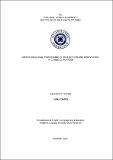DSpace Repository
MORPHOLOGICAL PROCESSING OF INFLECTION AND DERIVATION IN L1 AND L2 TURKISH
JavaScript is disabled for your browser. Some features of this site may not work without it.
| dc.contributor.author | CIMEN, Refika
|
|
| dc.date.accessioned | 2023-06-08T08:30:53Z | |
| dc.date.available | 2023-06-08T08:30:53Z | |
| dc.date.issued | 2021 | |
| dc.identifier.uri | http://hdl.handle.net/11547/9351 | |
| dc.description.abstract | The present study investigated how native speakers and second language learners of Turkish process inflectional and derivational word forms through a masked priming experiment. More specifically, the aim of this study was to find out whether the word category of target words was a determining factor for the processing route of inflected and derived prime words that preceded them. To this end, two lists of stimuli were prepared with a focus on two different word categories, i.e., verbs vs. nouns. In one list, prime words were followed by verbal target stems, whereas in the other list, they were followed by nominal target stems. Since it has been found in some earlier studies that morphologically-related primes can facilitate the processing of target words due to their orthographical and/or semantic relationship with the target words, the present study also incorporated orthographically and semantically related primes in both lists. As a result, each list included prime-target pairs in six different conditions: Identity (e.g. bakmak - BAKMAK, büyü - BÜYÜ), Inflection (e.g. baksa – BAKMAK, büyüyü - BÜYÜ), Derivation (e.g. bakım – BAKMAK, büyücü - BÜYÜ), Orthography (e.g. bakkal – BAKMAK, büyük - BÜYÜ), Semantic (e.g. gör – BAKMAK, sihir - BÜYÜ), Unrelated (e.g. tüket – BAKMAK, şeker – BÜYÜ). Another important feature of the current study is that the same target stems were used for different types of prime words, which makes this study unique. With this experimental design, we aimed to make a direct comparison between different conditions and thus determine the true nature of any priming effects. To explain, this design would allow us to find out whether the priming effects that we found were due to orthographical or semantic similarities between the primes and the targets or were resulting from a morphological relationship between the primes and the targets. The masked priming experiment was administered to 24 native speakers and nine L2 learners of Turkish at an SOA of 50 ms. The responses of the participants were then subjected to a mixed analysis of ANOVA. The results revealed several differences in the priming patterns of the nominal and verbal stimuli. First of all, L1 speakers of Turkish relied on different processing routes for inflected verbs and inflected nouns. We found a decompositional processing pattern for inflected verbs, but full-form storage for inflected nouns. On the other hand, word category did not lead to different priming patterns for nominal and verbal targets that followed derivational primes since full-priming effects were found for both word categories. As for L2 speakers of Turkish, word category was a significant factor for the preferred processing route of inflected word forms. It was found that inflected verbs did not prime their targets. However, L2 speakers showed a certain degree of sensitivity to xvii the morphological structure of inflected nouns. In a similar way, priming patterns differed for nominal and verbal targets that followed derivational primes. Partial priming effects were obtained for verbal targets following derivational primes, whereas derivational primes led to full-priming effects in nominal targets. This result suggests that L2 speakers of Turkish rely on different amounts of morphologically structured processing for derivational nouns and verbs. Finally, orthographically- and semantically-related words did not prime their targets at all, suggesting that all priming effects found in the current study were morphological in nature | tr_TR |
| dc.language.iso | en | tr_TR |
| dc.publisher | ISTANBUL AYDIN UNIVERSITY INSTITUTE OF SOCIAL SCIENCES | tr_TR |
| dc.title | MORPHOLOGICAL PROCESSING OF INFLECTION AND DERIVATION IN L1 AND L2 TURKISH | tr_TR |
| dc.type | Thesis | tr_TR |
Files in this item
This item appears in the following Collection(s)
-
Tezler -- Thesis [3470]
